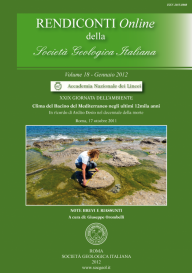
Climate changes and human settlements since the Bronze age period in central Italy
Anna Maria Mercuri (*) & Laura Sadori (**)
(*) Dipartimento di Biologia, Università di Modena e Reggio Emilia, Viale Caduti in Guerra 127, 41123 Modena, Italy. E-mail: mercuri.annamaria@unimore.it
(**) Dipartimento di Biologia Ambientale, Università "La Sapienza", Piazzale Aldo Moro 5, 00185 Roma, Italy. E-mail: laura.sadori@uniroma1.it
Volume: 18/2012
Pages: 32-34
Abstract
In the Mediterranean basin, crowd of many different civilizations, the environment was continuatively exploited during the Holocene. The onset of the Bronze age in Italy, archaeologically dated at ca. 4300-4200 years ago, is among the most problematic examples of a fairly synchronous cultural change probably driven by a climatic change. Terrestrial and marine cores, and archaeological layers preserve biological archives mirroring palaeoenvironmental changes. Obviously the human land transformation and managing are more evident in archaeological sites. When compared with off-site records, they help to evaluate the extent of human influence on an area. After the wet early Holocene phase, Mediterranean regions became progressively more arid, especially after the end of the 7th millennium BP. Cultural adaptations to mid-Holocene environmental changes are fairly evident in many pollen records since 5000-4000 years ago. Lago di Mezzano is an extraordinary example, as it represents an off-site / on-site mixed case. In many central Italian lakes, a mid-Holocene forest opening was evident, possibly also occurring several times in the range of few centuries. A climate shift towards aridity is visible in pollen diagrams around 4000 cal. yr. BP. Water shortage probably obliged Bronze age populations to settle along the lake shores in pile dwellings. Then, human landscapes expanded since around 3600 cal. yr BP, with cereals and legumes cultivation, olive diffusion, forest clearance, fire, and grazing activities.
Keywords
Get Full Text